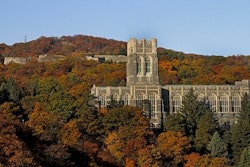Washington
National and local civil rights groups are hoping to
accomplish in Michigan what Texas officials failed to do during Hopwood
v. Texas — that is, prevent the restriction of educational
opportunities for Black and Latino students.
On February 5, the Detroit-based Citizens for Affirmative Action’s
Preservation (CAAP) and a coalition of national civil rights
organizations filed a motion in federal court on behalf of seventeen
African American and Latino high school students to allow them to join
the University of Michigan and its administrators as defendants in a
reverse discrimination lawsuit.
“The question is whether [public universities] can defend
affirmative action in the most vigorous way, given the political
pressures they face,” declared civil rights attorney Ted Shaw at a
recent news briefing in Washington, D.C.
The seventeen minority students are seeking to become defendants
“because the suit directly threatens their access to their State’s
flagship public institution of higher education and…may diminish
their access to colleges and universities throughout the state of
Michigan,” according to the motion filed last month.
“I think [the motion to intervene] puts a face on the Black and
Latino students who are affected by [the anti-affirmative action
suit].” said Pat Mendoza, regional director of the Mexican American
Legal Defense and Educational Fund.
The motion to intervene in the Michigan case marks a strategic move
by members of the civil rights community. It will allow them to argue
that the lawsuit represents a grave threat to educational access for
Black and Latino students.
National and state civil right organizations representing the
seventeen students include the NAACP Legal Defense and Educational
Fund, Inc., the American Civil Liberties Union, the ACLU Fund of
Michigan, and the Mexican American Legal Defense and Educational Fund.
Learning From the Past
When lawyers for the NAACP Legal Defense and Educational Fund
attempted to intervene on behalf of Black students in the Hopwood v.
Texas anti-affirmative action lawsuit, federal courts denied repeated
motions and appeals, ruling that the university was sufficiently
representing the students’ interests.
To civil rights groups, the Hopwood case — which resulted in the
ban of race and ethnicity as factors in Texas public university
admissions — has loomed as a painful reminder of the limitations that
public institutions have in representing the interests of minorities.
According to Shaw, one of the lessons from that case is that
“[public universities] are not the best institutions to defend the
interests of Black and Latino students.
“This is carefully chosen litigation,” said Shaw, who is associate
director counsel of the NAACP Legal Defense and Educational Fund.
The plaintiffs in the case are two White Michigan high school
graduates, Patrick Hamacher and Jennifer Gratz, who allege they were
denied admission to the University of Michigan because of their race.
The lawsuit, Gratz v. University of Michigan, was brought by the
Washington, D.C.-based Center for Individual Rights (CIR) on Oct. 14,
1997, in the Eastern District federal court in Michigan on behalf of
the White applicants. (For an in-depth look at CIR see the December 25,
1997 edition of Black Issues.)
CIR also represented Cheryl Hopwood, the plaintiff in Hopwood v. Texas.
“The idea that White students are being rejected because of race is false,” Shaw said.
Godfrey Dillard, the Detroit-based attorney who helped found CAAP,
said his organization was launched to allow Michigan residents and
others to oppose the anti-affirmative action crusades undertaken by
groups such as the CIR. He said organizations representing minorities
have largely stayed on the sidelines while major legal battles over
affirmative action have worked their way through the courts.
“Lawyers representing African Americans [and Latinos] can retake
control of the civil rights battle,” Dillard said of the motion to
intervene. “This is a new strategy. What you’ve seen recently were
conservative organizations suing predominantly White institutions over
affirmative action.”
“Our interest in the case over-laps with these institutions, but
it’s not the same,” Shaw said of the need for Blacks and Latinos to
argue for diversity and inclusion. “[Schools] are not going to fall on
their sword and admit to a history of discrimination.”
For its part, the University of Michigan has welcomed the
intervention by the civil rights groups and the students they represent.
“We are pleased that these intervenors are fully supportive of our
efforts to provide an integrated, diverse and high quality education,”
said Dr. Lee C. Bollinger, president of the University of Michigan.
“As I have stated from the outset,” he added, “the University of
Michigan is fully committed to defending its policies that consider
race as one factor among many for admission to the University.”
On February 23, the CIR filed a motion in opposition to the high
school students’ motion for intervention. The new motion argues that
the students have “no legally protected interests” with regard to the
University of Michigan’s affirmative action policies, says CIR
spokesman Terry Pell. Because the affirmative action program at the
university is voluntary, CIR contends the students have no legal basis
for joining the lawsuit as defendants.
As of late February, the federal judge in the Michigan case had not ruled on the motion to intervene.
COPYRIGHT 1998 Cox, Matthews & Associates
© Copyright 2005 by DiverseEducation.com


















